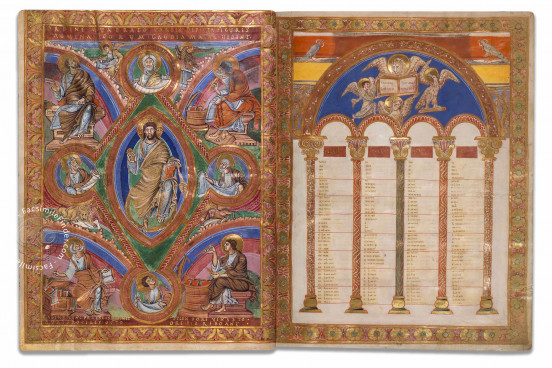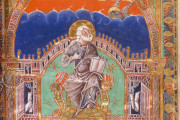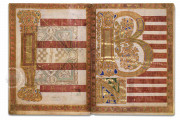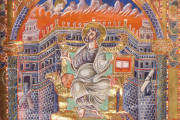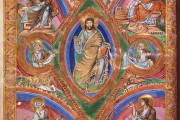The Codex Aureus of Saint Emmeram is a magnificently lavish manuscript completed in 870 likely at the monastery of Saint-Médard at Soissons in northern France. Commissioned by the king of West Francia (and soon to be Roman emperor) Charles the Bald, the majestic codex continues to be admired as a highlight of royal Carolingian book illumination.
Preserved in its sumptuous original treasure binding, the Codex Aureus contains the Gospels in Latin written entirely in gold. Following twelve Canon Tables which conclude with a Fountain of Life, each Gospel opens with decorated verses paired with a full-page Evangelist portrait, accompanied by a second opening comprising elaborate incipit pages that feature other symbols on sumptuously decorated fields showcasing an abundance of gold and rich colors.
The Brothers Liuthard and Beringar
A dedication poem at the end of the codex identifies the scribes responsible for the book, along with reporting the date of completion. Situated on fol. 126v, the colophon reveals the two priests were even brothers: "We two were born of the blood of one father and one mother, / and each of us serves the office of priest. / For us, here called by name Beringar and Liuthard."
In between frames gold and elaborate decorative motifs, brothers Liuthard and Beringar wrote the two columns of text containing the four Gospels in gold uncials throughout. Headings were given an imperial highlight of a purple ground, creating a dazzling contrast when the book was read under candlelight.
Made on the Order of the Aspiring Emperor
The elaborate outfitting of this manuscript naturally celebrates the ruler, depicted in one of history's most famous ruler portraits. On fol. 5v, the mustachioed Charles the Bald is enthroned on a jeweled throne under a ciborium with his feet on a podium of assorted stones while the personifications of the provinces of Francia and Gotia pay homage to him and the hand of God blesses him from above.
Read with the dedicatory poem on the top and bottom of the composition, and in conjunction with the accompanying leaf depicting the adoration of the Lamb, the imperial aspirations of the codex and its patron become quite clear.
Charles the Bald would be crowned emperor on Christmas in 875 and this codex was passed on to King Arnulf of East Francia. The manuscript was among those given by the king to the Abbey of St. Emmeram – the namesake of the manuscript – in 893.
The elaborately decorated page with the centrally depicted abbot opening the manuscript was likely added sometime during the abbacy of Abbot Ramwold, between 975-1000. Clearly aspiring to the imperial richness of the Codex Aureus, the caption identifying the "unworthy" abbot seems at odds with the richness of the manuscript's new frontispiece. The codex remained in the abbey till 1811 when it was finally brought to Munich.
Lavished in Gold, Gems, and Pearls
The term Codex Aureus is no exaggeration: this manuscript features its original treasure binding. The elaborate front cover is a masterpiece of repoussé gold reliefs in frames of precious gems and pearls.
Binding description
An extremely rare survival, this binding is one of the finest and very few surviving from the Middle Ages. Christ is represented enthroned, standing on the globe, framed by emerald green and blue jewels which profusely adorn the front cover.
Around the central illustration of Christ are gold repoussé pictures in chased fields representing the four evangelists and scenes of the life of Christ, all surrounded by glazing, filigree, and fine granulation of gold.
We have 1 facsimile edition of the manuscript "Codex Aureus of Saint Emmeram": Der Codex Aureus der Bayerischen Staatsbiliothek in München facsimile edition, published by Hugo Schmidt Verlag, 1921-25
Request Info / Price
